Family Acoraceae Rank Species | Order Acorales Genus Acorus Higher classification Acorus | |
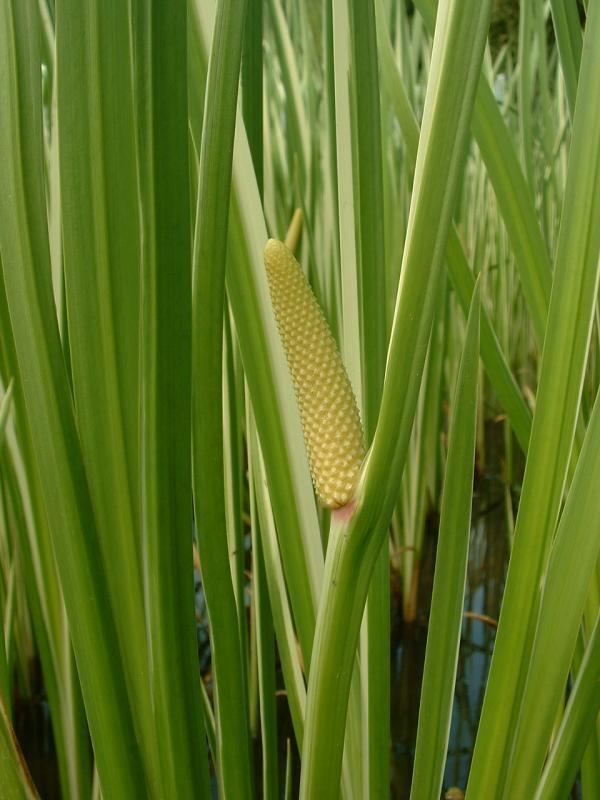 | ||
Similar Acorus, Acorus gramineus, Iris sanguinea, Yarrow, Common wormwood | ||
Acorus calamus
Acorus calamus (also called sweet flag or calamus, among many common names) is a tall perennial wetland monocot of the Acoraceae family, in the genus Acorus.
Contents
- Acorus calamus
- Acorus calamus and acorus gramineus
- Description
- Range and Habitat
- Names
- Etymology
- Botanical information
- Uses
- History
- Cultural uses
- Herbal medicine
- Hallucinogenic properties
- Horticulture
- Modern research
- Chemistry
- Cultural symbolism
- Safety and regulations
- References
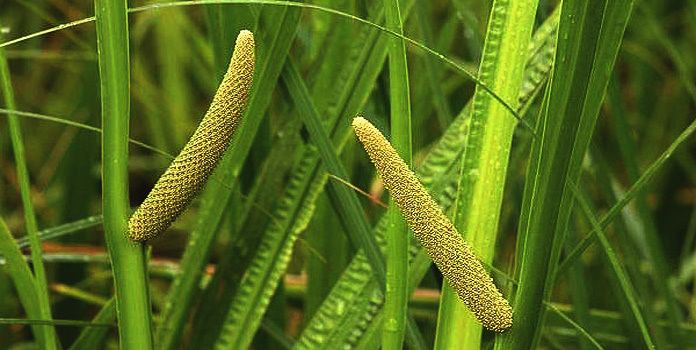
Acorus calamus and acorus gramineus
Description
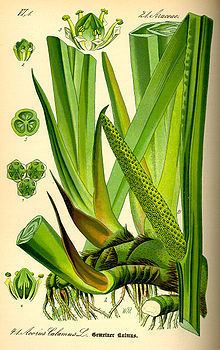
Sweet Sedge is a perennial herb, 30 to 100 cm tall. In habit it resembling the Iris. It consists of tufts of basal leaves that rise from a spreading rhizome. The leaves are erect yellowish-green, radical, with pink sheathing at their bases, sword-shaped, flat and narrow, tapering into a long, acute point, and have parallel veins. The leaves have smooth edges, which can be wavy or crimped. The sweet sedge can easily be distinguished of those of the Iris, and other similar plants, by the unusual crimped edges of the leaves, the fragant odour the emits when crushed, and the unusual flower spadix.
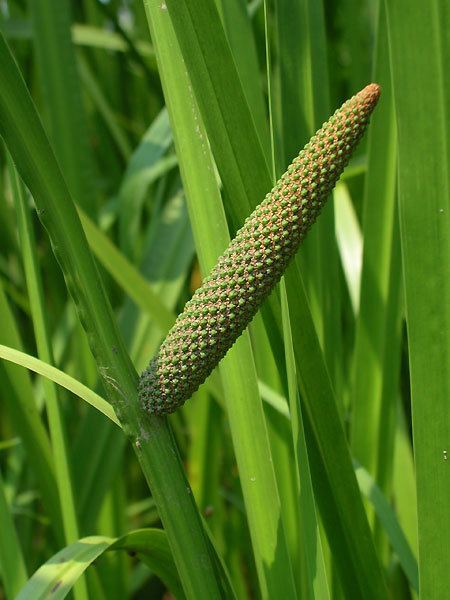
The solid, triangular flower-stems rise from the axils of the outer leaves. A semi-erect spadix emerges from one side of the flower stem. The spadix is solid, cylindrical, that tapers at each end, and is 5 to 10 cms. in length. A covering spathe, as is usual with Acoraceae, is absent. The spadix is densely crowded with tiny greenish-yellow flowers arranged in diamond-shaped pattern. Each flower contains six petals and stamens enclosed in a perianth with six divisions and surrounding a threecelled, oblong ovary with a sessile stigma. The flowers are sweetly fragrant. In Europe it flowers for about a month in late spring or early summer, but usually does not bear fruit there. Only plants that grow in water bear flowers. The fruit is a berry filled with mucus, which when ripe falls into the water and thus disperses. Even in Asia it fruits sparingly and propagates itself mainly by spreading its rhizome, forming colonies.
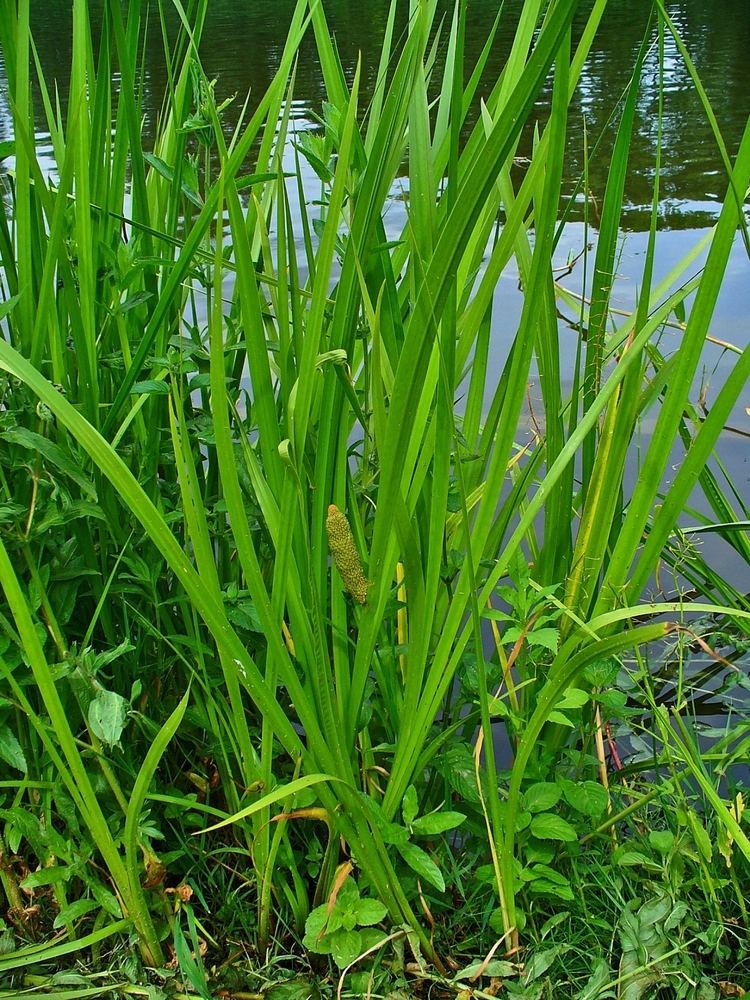
The branched, cylindrical, knobby rhizome is about a finger thick and has numerous coarse fibrous roots below it. The exterior is brown and the interior white.
Range and Habitat
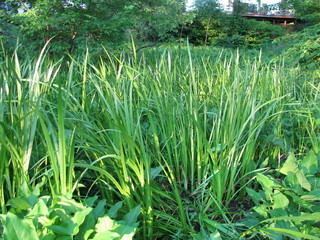
Sweet Flag is native to India, central Asia, southern Russia and Siberia, and perhaps Eastern Europe. It also grows in China and Japan. It was introduced into Western Europe and North America for medicinal purposes. Habitats include edges of small lakes, ponds and rivers, marshes, swamps, and wetlands.
Names
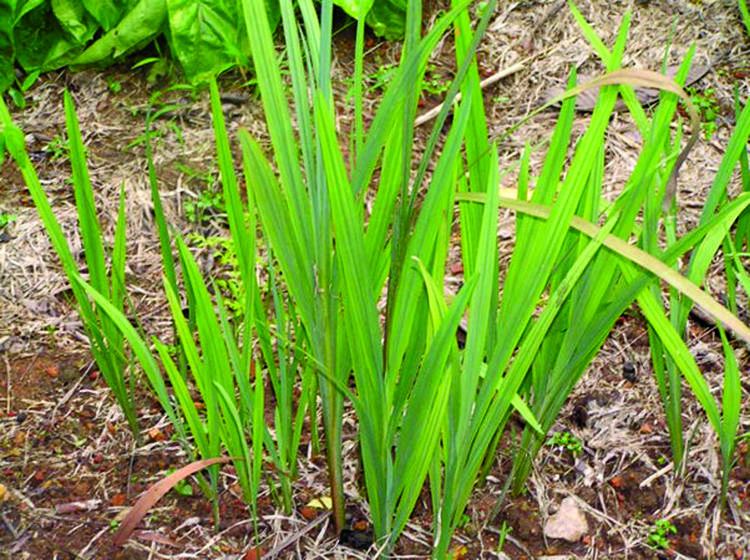
In addition to "sweet flag" and "calamus" other common names include beewort, bitter pepper root, calamus root, flag root, gladdon, myrtle flag, myrtle grass, myrtle root, myrtle sedge, pine root, rat root, sea sedge, sweet cane, sweet cinnamon, sweet grass, sweet myrtle, sweet root, sweet rush, and sweet sedge. Common names in Asia include: "Changpu 菖蒲" (Mandarin Chinese); "shoubu 菖蒲" (Japanese); "vacha"; "changpo 창포" (Korean); "bacch" (Unani); "bajai", "gora-bach", "vasa bach" (Hindi); "vekhand" (Marathi); "vasambu"/வசம்பு (Tamil); "vadaja", "vasa" (Telugu); "baje" (Kannada); "vayambu" (Malayalam); Haimavati, "bhutanashini", "jatila" (Sanskrit), "kâmpean" កំពាន (Khmer) and "bojho बोझो" (Nepali).
Etymology
The generic name is the Latin word acorus, which is derived from the Greek άχόρου (áchórou) of Dioscorides (note different versions of the text have different spellings). The word άχόρου itself is thought to have been derived from the word κόρη (kóri), which means pupil (of an eye), because of the juice from the root of the plant being used as a remedy in diseases of the eye ('darkening of the pupil').
The specific name calamus (meaning "cane") is derived from Greek ΚΆΛΑΜΟΣ (kálamos, meaning "reed"), which is cognate to Latin culmus (meaning "stalk") and Old English healm (meaning "straw"), and derived from Proto-Indo European *kole-mo- (thought to mean "grass" or "reed"). The Arabic word قَلَم (qálam, meaning "pen") and Sanskrit कलम (kaláma, meaning "reed used as a pen", and a sort of rice) are thought to have been borrowed from Greek.
The name sweet flag refers to its sweet scent and its similarity to Iris species, which are commonly known as flags in English since the late fourteenth century.
Botanical information
Currently the taxonomic position of these forms is contested. The comprehensive taxonomic analysis in the Kew World Checklist of Selected Plant Families from 2002 considers all three forms to be distinct varieties of a single species. Sue A. Thompson in her 1995 Ph.D. dissertation and in her 2000 entry in the Flora of North America considers the diploid form to be a distinct species. Thompson only analyses North American forms of the diploid variety in her treatment, and does not analyse the morphology of Asian forms of the diploid variety. Also, in older USA literature the name Acorus americanus may be used indiscriminately for all forms of Acorus calamus occurring in North America, irrespective of cytological diversity (i.e. both the diploid and triploid forms). The recent treatment in the Flora of China from 2010, which is followed in the Tropicos database system, considers all varieties to be synonyms of a single taxonomically undifferentiated species, pointing to morphological overlap in the characteristics singled out by Thompson.
According to Thompson the primary morphological distinction between the triploid and the North American forms of the diploid is made by the number of prominent leaf veins, the diploid having a single prominent midvein and on both sides of this equally raised secondary veins, the triploid having a single prominent midvein with the secondary veins barely distinct. Thompson notes a number of other details which she claims can be used to tell the different forms apart in North America, such as flower length, average maximum leaf length, relative length of the sympodial leaf with respect to the vegetative leaves, the average length of the spadix during flowering, and tendency of the leaf margin to undulate in the triploid. She notes that many of these characteristics overlap, but that in general the triploid is somewhat larger and more robust on average than most North American forms of the diploid. According to Heng Li, Guanghua Zhu and Josef Bogner in the Flora of China there is clear overlap in these characteristics and the different cytotypes are impossible to distinguish morphologically.
Triploid plants are infertile and show an abortive ovary with a shrivelled appearance. This form will never form fruit (let alone seeds) and can only spread asexually.
The tetraploid variety is usually known as Acorus calamus var. angustatus Besser. A number of synonyms are known, but a number are contested as to which variety they belong. It is morphologically diverse, with some forms having very broad and some narrow leaves. It is furthermore also cytotypically diverse, with an array of different karyotypes.
Uses
A. calamus has been an item of trade in many cultures for thousands of years. It has been used medicinally for a wide variety of ailments, and its aroma makes calamus essential oil valued in the perfume industry. The essence from the rhizome is used as a flavor for pipe tobacco. When eaten in crystallized form, it is called "German ginger". In Europe Acorus calamus was often added to wine, and the root is also one of the possible ingredients of absinthe. It is also used in bitters. In Lithuania Ajeras (Sweet flag) is added to home baked black bread.
History
The Bible mentions its use in the holy anointing oil ( Exodus 30: 23). Although probably not native to Egypt, this plant was already mentioned in the Chester Beatty papyrus VI dating to approximately 1300 BC. The ancient Egyptians rarely mentioned the plant in medicinal contexts (the aforementioned papyrus mentioned using it in conjunction with several ingredients as a bandage used to soothe an ailment of the stomach), but it was certainly used to make perfumes.
Initially, Europeans confused the identity and medicinal uses of the Acorus calamus of the Romans and Greeks with their native Iris pseudacorus. Thus the Herbarius zu Teutsch, published at Mainz in 1485, describes and includes a woodcut of this iris under the name Acorus. This German book is one of three possible sources for the French Le Grant Herbier, written in 1486, 1488, 1498 or 1508, of which an English translation was published as the Grete Herball by Peter Treveris in 1526, all containing the false identification of the Herbarius zu Teutsch. William Turner, writing in 1538, describes 'acorum' as "gladon or a flag, a yelowe floure delyce".
The plant was introduced to Britain in the late 16th century. By at least 1596 true Acorus calamus was grown in Britain, as it is listed in The Catalogue, a list of plants John Gerard grew in his garden at Holborn. Gerard notes "It prospereth exceeding well in my garden, but as yet beareth neither flowers nor stalke". Gerard lists the Latin name as Acorus verus, but it is evident there was still doubt about its veracity: in his 1597 herbal he lists the English common name as 'bastard calamus'.
Cultural uses
In Britain the plant was cut for use as a sweet smelling floor covering for the packed earth floors of dwellings and churches, and stacks of rushes have been used as the centrepiece of rushbearing ceremonies for many hundreds of years. It has also been used as a thatching material for English cottages.
In modern Egypt it is thought to have aphrodisiac properties.
For the Penobscot people this was a very important root. One story goes that a sickness was plaguing the people. A muskrat spirit came to a man in a dream, telling him that he (the muskrat) was a root and where to find him. The man awoke, found the root, and made a medicine which cured the people. In Penobscot homes, pieces of the dried root were strung together and hung up for preservation. Steaming it throughout the home was thought to "kill" sickness. While they were travelling, a piece of root was kept and chewed to ward off illness.
Teton-Dakota warriors chewed the root to a paste, which they rubbed on their faces. It was thought to prevent excitement and fear when facing an enemy.
The Potawatomi people powdered the dried root and placed this up the nose to cure catarrh.
On 5 May Japanese prepare a bath with hashōbu leaves (shōbu-yu) for children to promote good health and to ward-off evil. In the Japanese calendar the day is known as Ayame no sekku (菖蒲の節句, the iris festival).
Herbal medicine
Sweet flag has a very long history of medicinal use in Chinese and Indian herbal traditions. The leaves, stems, and roots are used in various Siddha and Ayurvedic medicines. It is widely employed in modern herbal medicine for its sedative, laxative, diuretic, and carminative properties. It is used in Ayurveda to counter the side effects of all hallucinogens. Sweet Flag, known as "Rat Root" is one of the most widely and frequently used herbal medicines amongst the Chipewyan people.
Hallucinogenic properties
Chewing the rootstock of the plant can cause visual hallucinations, possibly because of the presence of alpha-asarone or beta-asarone.
Horticulture
This plant is sometimes used as a pond plant in horticulture. There is at least one ornamental cultivar known; it is usually called 'Variegatus', but the RHS recommends calling it 'Argenteostriatus'.
Modern research
Acorus calamus shows neuroprotective effect against stroke and chemically induced neurodegeneration in rats. Specifically, it has protective effect against acrylamide-induced neurotoxicity.
Both roots and leaves of A. calamus have shown antioxidant proeprties.
Acorus calamus may prove to be an effective control measure against cattle tick, Rhipicephalus (Boophilus) microplus.
A recent study showed that beta-asarone isolated from Acorus calamus oil inhibits adipogenesis in 3T3-L1 cells and thus reduces lipid accumulation in fat cells.
Chemistry
Both triploid and tetraploid A. calamus contain alpha-asarone. Other phytochemicals include:
Diploids do not contain beta-asarone (β-asarone).
Cultural symbolism
The calamus has long been a symbol of love. The name is associated with a Greek myth: Kalamos, son of the river-god Maeander, who loved the youth Karpos, of Zephyrus (the West Wind) and Chloris (Spring). When Karpos drowned in a swimming race, Kalamos also drowned and was transformed into a reed, whose rustling in the wind was interpreted as a sigh of lamentation.
The plant was a favorite of Henry David Thoreau (who called it "sweet flag"), and also of Walt Whitman, who added a section called the "Calamus" poems, to the third edition of Leaves of Grass (1860). In the poems the calamus is used as a symbol of love, lust, and affection.
The root of the calamus (Tamil vasambu வசம்பு) is cut into disc-shaped beads, and made into bracelets, which are typically worn by newborns for the first few months. A vasambu bracelet is a symbol of a newborn baby in Tamil culture.
Safety and regulations
A. calamus and products derived from A. calamus (such as its oil) were banned from use as human food or as a food additive in 1968 by the United States Food and Drug Administration. The FDA ban was the result of lab studies that involved supplementing the diets of lab animals over a prolonged period of time with massive doses of isolated chemicals (β-asarone) from the Indian Jammu strain of calamus. The animals developed tumors, and the plant was labeled procarcinogenic. Wichtl says "It is not clear whether the observed carcinogenic effects in rats are relevant to the human organism." However, most sources advise caution in ingesting strains other than the diploid strain.
In reality β-asarone is neither hepatotoxic nor directly hepatocarcinogenic. It must first undergo metabolic l'-hydroxylation in the liver before achieving toxicity. Cytochrome P450 in the hepatocytes is responsible for secreting the hydrolyzing enzymes that convert β-asarone into genotoxic epoxide structure. Even with the activation of these metabolites, the carcinogenic potency is very low because of the rapid breakdown of epoxide residues with hydrolase which leaves these compounds inert. Additionally, the major metabolite of β-asarone is 2,4,5-trimethoxycinnamic acid, a derivative which is not a carcinogen.
